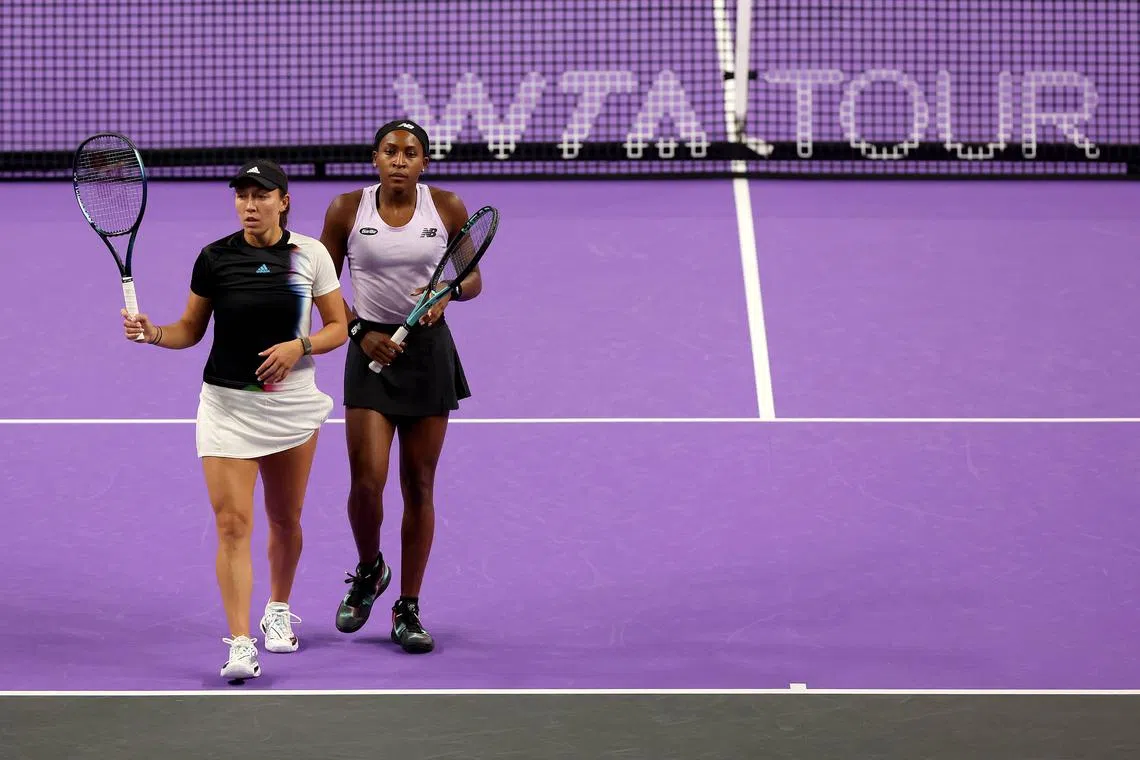Tennis: The disarray of the WTA
Sign up now: Get the biggest sports news in your inbox

Jessica Pegula (left) and Coco Gauff at the Women's Doubles Group Stage match during the 2022 WTA Finals at Dickies Arena on Oct 31.
PHOTO: AFP
Follow topic:
NEW YORK – As the women’s professional tennis season draws to a close this week, with the Women’s Tennis Association (WTA) Finals in Fort Worth, Texas, it is fair to call this a Dickensian year – the best of times, the worst of times.
Rarely since the founding of the WTA Tour in 1973 has the women’s game experienced as much tumult as it did in 2022. There were enormous highs and shattering lows, much to be proud of and plenty to be concerned about.
“This was certainly a year filled with challenges in the women’s game. Not only did we lose an anchor when the established No. 1 retired, but doing business hasn’t been easy in this post-Covid world,” Pam Shriver, a former player who once served as the president of the WTA Tour Players’ Association, said, referring to the departure of Ashleigh Barty.
After two years of pandemic-related interruptions, the tour welcomed fans back unconditionally to arenas worldwide. Players once again signed giant tennis balls courtside and threw their sweaty wristbands into eager crowds. The enthusiasm at late-night matches in New York and Miami reminded athletes just how much they had missed that raucous interaction.
There was pomp and emotion when Serena Williams left the game after the US Open.
There were also tender moments, such as when Barty won the Australian Open in January she abruptly announced her retirement,
Iga Swiatek proved to be a willing successor. The 21-year-old won 37 consecutive matches from February to June, including at top-tier events at Indian Wells, Miami, Rome and the French Open. By the fall, she had added her second Slam of the year at the US Open. Swiatek heads into the WTA Finals with eight titles for the season, the most since Williams won 11 in 2013.
The Pole is returning to the year-end championships for the second time. The fact that the WTA Finals are being held in Texas, rather than in China, is yet another point of contention. The tournament was supposed to be played in Shenzhen, as it was in 2019, when China made a US$500 million (S$705.8 million) investment in women’s tennis, including US$14 million in prize money for the year-end championships. The plan was for the event to be staged there every year until 2028.
But in 2020, the tournament was cancelled because of the pandemic. Then, last December, Peng Shuai, a Chinese tennis star at the time, posted a social media message in which she accused a high-ranking Chinese government official of sexual assault.
It took WTA president Micky Lawler months to secure an alternate venue for the Finals, which were temporarily moved to Guadalajara, Mexico, in 2021. In 2022, after much consideration, the WTA chose the 14,000-seat Dickies Arena in Fort Worth as the venue. All the costs, including fees and prize money for the eight singles competitors and eight doubles pairs, are being absorbed by the WTA.
But the biggest issue in women’s tennis now is financial stability. Despite the WTA adding Hologic as a title sponsor this year, the loss of revenue from China has forced the tour to operate at a deficit all season. Saudi Arabia tried this year to step in and make an investment, but it was rebuffed.
To rebuild its financial house, the WTA is set to announce that CVC Capital Partners, a private equity firm, is investing US$150 million over the next five years to hold a 20 per cent stake in the tour.
Simon declined to be interviewed about the deal – much of that money would reportedly go towards equalising prize money between the WTA and the ATP. But Lawler said it was not all about prize money distribution.
“It is important that we invest in our own assets, such as content and broadcast production,” she said. “They drive the overall value of the sport for all of our stakeholders. As far as technology, we have seen innovation in areas such as ball and athlete tracking. If we add these data points to the data output from the umpire’s chair, we are able to produce deep match insights. Both our athletes and fans expect us to tell stories with every tool available.” NYTIMES

